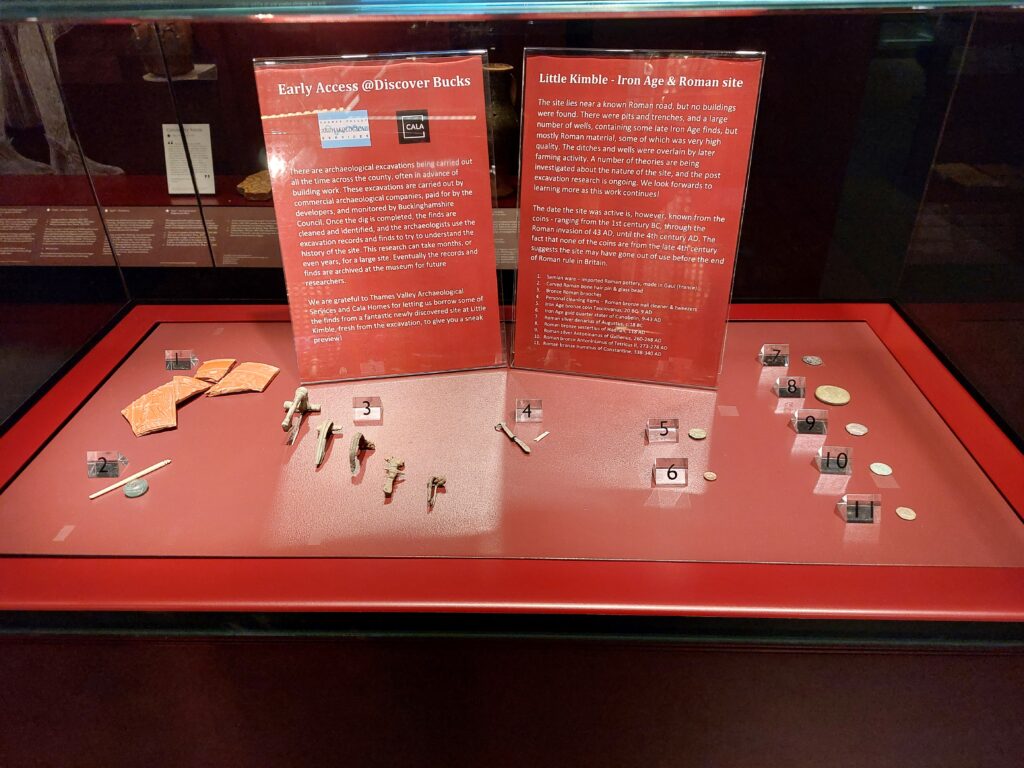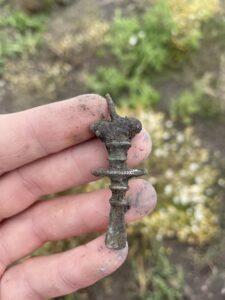TVAS Reading: Site Update: Excavations at Little Kimble, Buckinghamshire
TVAS Reading: Site Update: Excavations at Little Kimble, Buckinghamshire

Drone view of site, facing towards Lower Icknield Way
In 2023 an archaeological excavation was carried out by Thames Valley Archaeological Services ahead of a new development of 45 residential units at Little Kimble on behalf of Cala Homes Ltd. This excavation revealed a wealth of finds and features from several time periods, with the majority of the occupation evidence dating to the Late Iron Age and Roman periods. The site itself is located along a roadway believed to have been in use during the Roman period (the Lower Icknield Way), suggesting this site could be some iteration of a roadside settlement. A likely trackway or droveway was identified within the site, coming from the Lower Icknield Way at a right angle and heading across the site, potentially being an access point off the road.

Harriet, Archaeological Officer, excavating a cremation

Cremation with plate
The site was mainly characterised by numerous ditches and gullies which would have acted as land divisions for settlement and agricultural use. Several enclosed areas were identified on the southern boundary of the site- which potentially would have been for residential purposes or to house livestock. Sadly, no traces of structures were identified within the enclosed areas or elsewhere on site, which is a fairly typical observation and hints towards non-earthfast foundations, but the presence of rubbish pits and personal dress items indicates a settlement. This is further proved by the discovery of eight graves within the site, all of which were in the form of cremations – a practice of burial which is not uncommon from the Roman period. One of the graves had an associated plate deposited with the individual, with the rest being without associated deposits or ‘grave goods’. Five out of the eight graves in the north of site are separated by a boundary ditch, away from the roadside which seems to be the foci of the settlement, showing land use and division by the people living there.

Tom, Assistant Site Superviosr, recording a well
A defining feature of this site comes in the form of the unusually high number of wells uncovered by the excavation – 14 in total. These wells varied in depth, size and shape, and were concentrated mainly in the southern half of the excavation area. The number of wells alludes to the longevity of the settlement; however, it is entirely possible that some of the wells would have been in use at the same time, with some being used as seasonal wells due to the slow water percolation of the local geology – something that was observed during the excavation!

Copper alloy coin

Iron-Age gold quarter stater

Iron-Age gold quarter stater

Copper alloy coin

Silver coin
A high number of metal finds were recovered from the excavation, with a full metal detector survey of the site yielding 44 coins and personal dress items such as rings, bracelets and brooches. The recovery of these dress items combined with several organic examples such as bone hairpins gives us a rare glimpse into the fashion of the times as well as the trade links with the wider Roman world. Out of the coin assemblage, seven pre-Roman conquest coins were found. These included two Iron-Age gold quarter staters and two bronze coins, and three silver Roman coins, one of which dates to the Roman Republic and was likely minted in Rome itself. These high status finds, along with imported samian pottery from Gaul, indicate the trade links the settlement had with the Roman world before the conquest. Due to its position along a known road and trade route, it is possible that this site could have started out as a trading settlement. However, the presence of Roman roof tiles and box flue tiles (for an underfloor heating system) hints at there being a building of some status in the immediate vicinity, which could suggest the site is part of the environs of a wider villa complex. These two theories are not mutually exclusive.
The field has been extensively ploughed from the Medieval period onwards, which has brought a lot of finds out of their original context, but has not seemed to damage the site in any substantial way. The high number of finds recovered from this site will help us better understand the connection between the local Iron Age population and the wider Roman world, and how these two worlds interreacted before and after the Claudian invasion in 45 AD.
Some of the finds are now on display at the Discover Bucks Museum for a limited time!

Finds on display at the Discover Bucks Museum

Finds on display at the Discover Bucks Museum
Below is a selection of photos from the excavations.

Richard, Senior Archaeological Officer, excavating a vessel

Part of a toiletry set

Glass bead

Copper alloy brooch

Bone pin

Copper alloy brooch
